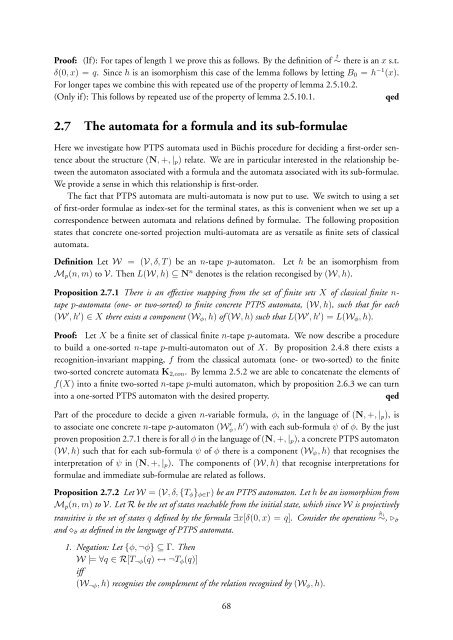On the methods of mechanical non-theorems (latest version)
On the methods of mechanical non-theorems (latest version)
On the methods of mechanical non-theorems (latest version)
Create successful ePaper yourself
Turn your PDF publications into a flip-book with our unique Google optimized e-Paper software.
Pro<strong>of</strong>: (If): For tapes <strong>of</strong> length 1 we prove this as follows. By <strong>the</strong> definition <strong>of</strong> ∼ t <strong>the</strong>re is an x s.t.<br />
δ(0, x) = q. Since h is an isomorphism this case <strong>of</strong> <strong>the</strong> lemma follows by letting B 0 = h −1 (x).<br />
For longer tapes we combine this with repeated use <strong>of</strong> <strong>the</strong> property <strong>of</strong> lemma 2.5.10.2.<br />
(<strong>On</strong>ly if): This follows by repeated use <strong>of</strong> <strong>the</strong> property <strong>of</strong> lemma 2.5.10.1.<br />
qed<br />
2.7 The automata for a formula and its sub-formulae<br />
Here we investigate how PTPS automata used in Büchis procedure for deciding a first-order sentence<br />
about <strong>the</strong> structure (N, +, | p ) relate. We are in particular interested in <strong>the</strong> relationship between<br />
<strong>the</strong> automaton associated with a formula and <strong>the</strong> automata associated with its sub-formulae.<br />
We provide a sense in which this relationship is first-order.<br />
The fact that PTPS automata are multi-automata is now put to use. We switch to using a set<br />
<strong>of</strong> first-order formulae as index-set for <strong>the</strong> terminal states, as this is convenient when we set up a<br />
correspondence between automata and relations defined by formulae. The following proposition<br />
states that concrete one-sorted projection multi-automata are as versatile as finite sets <strong>of</strong> classical<br />
automata.<br />
Definition Let W = (V, δ, T ) be an n-tape p-automaton. Let h be an isomorphism from<br />
M p (n, m) to V. Then L(W, h) ⊆ N n denotes is <strong>the</strong> relation recongised by (W, h).<br />
Proposition 2.7.1 There is an effective mapping from <strong>the</strong> set <strong>of</strong> finite sets X <strong>of</strong> classical finite n-<br />
tape p-automata (one- or two-sorted) to finite concrete PTPS automata, (W, h), such that for each<br />
(W ′ , h ′ ) ∈ X <strong>the</strong>re exists a component (W φ , h) <strong>of</strong> (W, h) such that L(W ′ , h ′ ) = L(W φ , h).<br />
Pro<strong>of</strong>: Let X be a finite set <strong>of</strong> classical finite n-tape p-automata. We now describe a procedure<br />
to build a one-sorted n-tape p-multi-automaton out <strong>of</strong> X. By proposition 2.4.8 <strong>the</strong>re exists a<br />
recognition-invariant mapping, f from <strong>the</strong> classical automata (one- or two-sorted) to <strong>the</strong> finite<br />
two-sorted concrete automata K 2,con . By lemma 2.5.2 we are able to concatenate <strong>the</strong> elements <strong>of</strong><br />
f(X) into a finite two-sorted n-tape p-multi automaton, which by proposition 2.6.3 we can turn<br />
into a one-sorted PTPS automaton with <strong>the</strong> desired property.<br />
qed<br />
Part <strong>of</strong> <strong>the</strong> procedure to decide a given n-variable formula, φ, in <strong>the</strong> language <strong>of</strong> (N, +, | p ), is<br />
to associate one concrete n-tape p-automaton (W ′ ψ, h ′ ) with each sub-formula ψ <strong>of</strong> φ. By <strong>the</strong> just<br />
proven proposition 2.7.1 <strong>the</strong>re is for all φ in <strong>the</strong> language <strong>of</strong> (N, +, | p ), a concrete PTPS automaton<br />
(W, h) such that for each sub-formula ψ <strong>of</strong> φ <strong>the</strong>re is a component (W ψ , h) that recognises <strong>the</strong><br />
interpretation <strong>of</strong> ψ in (N, +, | p ). The components <strong>of</strong> (W, h) that recognise interpretations for<br />
formulae and immediate sub-formulae are related as follows.<br />
Proposition 2.7.2 Let W = (V, δ, {T φ } φ∈Γ ) be an PTPS automaton. Let h be an isomorphism from<br />
M p (n, m) to V. Let R be <strong>the</strong> set <strong>of</strong> states reachable from <strong>the</strong> initial state, which since W is projectively<br />
transitive is <strong>the</strong> set <strong>of</strong> states q defined by <strong>the</strong> formula ∃x[δ(0, x) = q]. Consider <strong>the</strong> operations ˆπ i<br />
∼, ⊲ˆσ<br />
and ⋄ˆσ as defined in <strong>the</strong> language <strong>of</strong> PTPS automata.<br />
1. Negation: Let {φ, ¬φ} ⊆ Γ. Then<br />
W |= ∀q ∈ R[T ¬φ (q) ↔ ¬T φ (q)]<br />
iff<br />
(W ¬φ , h) recognises <strong>the</strong> complement <strong>of</strong> <strong>the</strong> relation recognised by (W φ , h).<br />
68
















